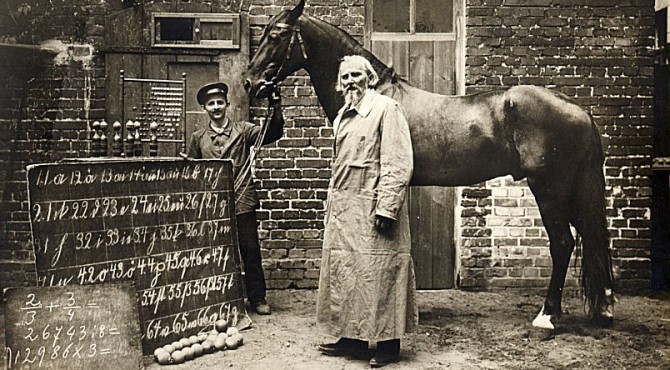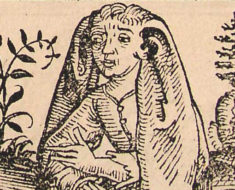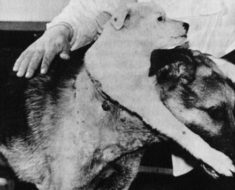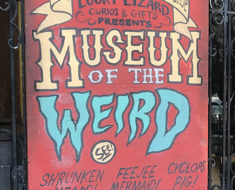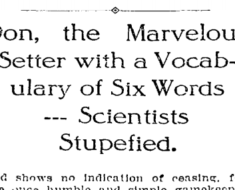In 1935, psychic investigator Harry Price and R.S. Lambert, editor of a BBC weekly magazine called The Listener went to the Isle of Man to meet a talking mongoose.
The mongoose, who called himself Gef, claimed to be 83 years old and originally from India. An account in British Broadcasting: Radio and Television in the United Kingdom, states Gef allegedly spoke English, but knew some Russian, Manx, Hebrew, Welsh, Hindustani, Flemish, Italian and Arabic.
It could even sing and dance, and “had an intimate knowledge of various makes of motor cars, and took a great interest therein, and in flying, and often spent days studying the latest machines; could play ball; coughed in a manner which was absolutely human; had killed 118 rabbits, but was careful not to do so out of season; was something of an arithmetician; could transform itself into a cat…”
You get the point. This was one very talented mongoose.
![An example of what Gef may have looked like (which is any mongoose). By Pearson Scott Foresman [Public domain], via Wikimedia Commons](http://www.weirdhistorian.com/wp-content/uploads/2017/12/Mongoose_PSF.png)
An example of what Gef may have looked like (which is any mongoose). By Pearson Scott Foresman [Public domain], via Wikimedia Commons
So the Irvings decided to embrace Gef. Impressed with his many sounds, they began to challenge him with noises of their own—each of which he recreated. Voirrey took the tests a step further and taught him nursery rhymes. Sure enough, the clever mongoose emulated those, too, speaking quite clearly.
As Price wrote in his 1936 book, Confessions of a Ghost Hunter, “From that day onwards the ‘talking mongoose’ became an intimate and valued member of the Irving family. The voice is stated to be two octaves above the human voice, and very clear and distinct.”
With everyone getting along so well, Gef expressed his dismay at being shot at. Irving apologized, explaining he thought the mongoose was nothing more than a common nuisance. He had no idea such a accomplished animal had made a home inside the walls of their home.
The little weasel began to attract attention outside the Irving home. As recounted in 1996’s Psychic Pets & Spirit Animals: True Stories from the Files of Fate Magazine, reporters began to visit the farm and claimed to hear Gef speak. Another visitor took a walk with Irving, had lunch and discussed Mrs. Irving’s shoes. Upon their return, Mrs. Irving knew everything that had been discussed. Gef had followed the two men and reported back to Mrs. Irving.
In a letter inviting Price to visit his home and meet Gef, Irving described the creature as “being of a yellowish tinge, like a ferret. The tail is long and bushy and tinged with brown.” However, Irving rarely saw the creature, although his family claimed to see him face to face several times. Voirrey tried photographing him, but Gef refused to sit still, claiming that he believed the camera to be a trap. Therefore, like Bigfoot and the Loch Ness Monster, no clear photos of the elusive fellow exist.
Price originally hesitated at Irving’s invitation, but eventually changed his mind.
I argued to myself that there might be something in it. After all, talking animals are fairly common—in print. The pages of A Thousand and One Nights, Aesop’s Fables, Sir J. G. Frazer’s The Golden Bough and scores of books on mythology are full of talking beasts which are human in everything but shape. Today, the Australian natives believe that the wild dog has the power of speech; and the Breton peasants credit all birds with language, which they try to interpret. The bear in Norway is regarded as almost a man. … Even in psychical research talking animals are not unknown. Who has not heard of the Elberfeld horses, Muhamed, Zarif, Hanschen and Barto? Certainly, these equine wonders spoke with their hoofs, and not with their mouths—but they made themselves understood just the same. … Then there was Rolf, the Mannheim ‘talking dog’, Black Bear, the Briarcliff ‘thinking pony’, and many others. And we have all kept talking parrots.”
So Price decided a talking mongoose just might be possible and invited Lambert to join him. Lambert found the whole thing absurd, but looked forward to writing about it.
Unfortunately, just as they arrived Gef had gone missing. The Irvings suggested that maybe Gef was just hiding quietly in the house, listening to everything being told to the two investigators.
![From the Manchester D. Dispatch, January 11, 1932. By Anonymous [Public domain], via Wikimedia Commons](http://www.weirdhistorian.com/wp-content/uploads/2017/12/Gef_Mongoose_ventriloquism.jpg)
From the Manchester D. Dispatch, January 11, 1932. By Anonymous [Public domain], via Wikimedia Commons
Instead, all they heard were the Irvings’ tales of Gef’s adventures. The mongoose not only hung around the house, but also found his way around town and delivered gossip upon his return.
Price and Lambert were frustrated. Their talking mongoose had gone mute and they began to wonder if the whole thing was a fraud. They wondered what motive the Irvings would have. It didn’t make sense. Had someone been playing a trick on them? Voirrey was said to have ventriloquism skills. Was it all her doing? Price claims the Irvings heard Gef while their daughter was under supervision, and that they’d heard him when she wasn’t around. Then again, perhaps Voirrey was just more clever than they gave her credit for. If this was the case, it had lasted nearly four years, which was a long time for the parents to be unaware of such a hoax.
After another day, Price and Lambert left. Lo and behold, Gef returned home right afterward and claimed he had remained invisible because Lambert doubted his existence. Too bad Gef didn’t prove Lambert wrong with a simple, “Hello.”
In Robert Graves and Alan Hodge’s 1940 book, The Long Week-end: A Social History of Great Britain, they state that Price and Lambert wrote about their experiences during their return to London. “They discussed the possibility of poltergeist activity on the part of the Irving’s daughter,” the book says, “and suggested that a deliberately created family legend might have taken such hold that the family itself had come to believe in it; yet they did not entirely rule out the possibility of the Irvings’ account being a true one.”

